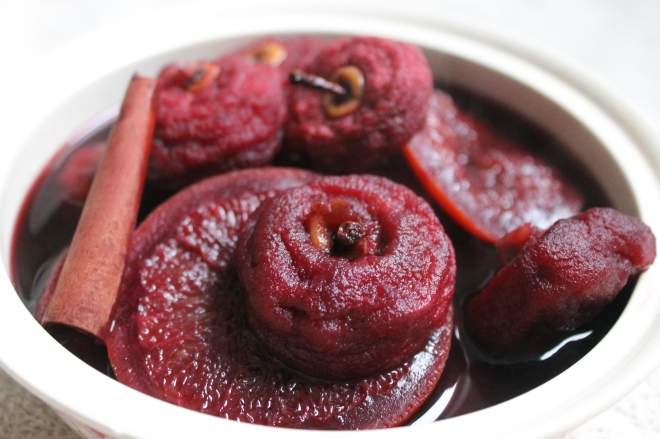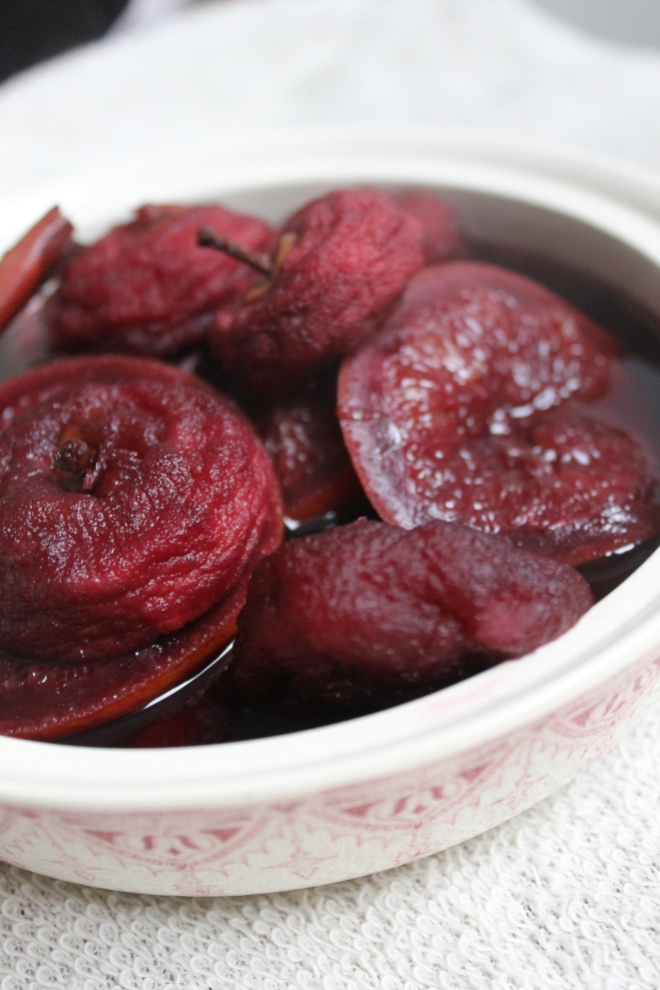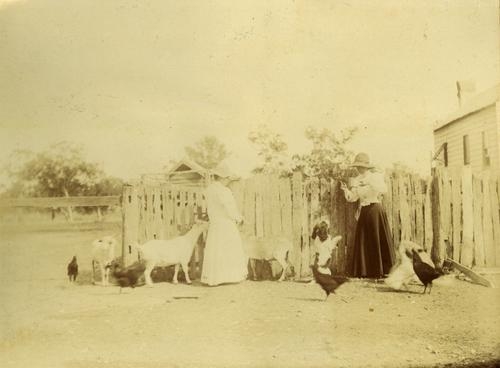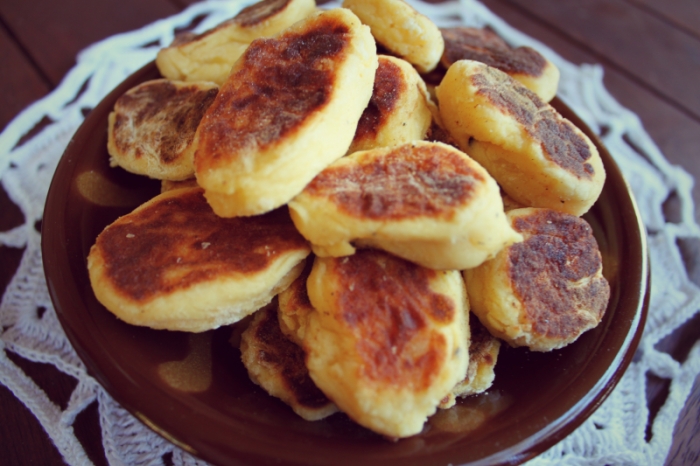The next challenge for the Historical Food Fortnightly is “Ethnic Foodways” and given that I’m in France I thought this was a great opportunity to explore the history of some of the local specialities. Well, I have to report mixed results. The modern sources all seem to be quoting each other, and even if you can discover what the original source was, that’s no guarantee that it is an any way accessible (my Latin is non-existent and $300 first edition cookbooks are a little out of my price-range). Nonetheless, I think I have been able to pin down enough to give you a bit of a glimpse into two local specialities (the second is coming soon).
First up, pommes et poires tapées or dehydrated, flattened apples and pears. They might not sound too appetising at this point, but they’re actually not all that different from the dried apple rings you can buy in the supermarket. Drying fruit to preserve it is a time-honoured tradition, going all the way back to prehistory. In France, archaeologists interpret pieces of carbonised fruit dating to the late Iron Age as evidence of dried fruits.[1] Jumping forward a bit but staying surprisingly close geographically, in 1560 the king’s physician Jean Bruyérin-Champier referred to pears and apples which were dried in ovens around Orleans and Tours.[2]
 By the beginning of the 18th century, a rather unusual technique had developed with whole fruits (apples, pears and peaches) being dried in the oven for several days, and gently pressed with a wooden implement to flatten them. It is widely believed that fruit dried in this way was a staple for sailors, and that the flattening was to make them more space-efficient on ships. The industry expanded over the next hundred years, and in 1878 the region was exporting some 500,000 kg of dried fruit, but the glory days of pommes tapées weren’t to last. Refrigeration and cheap imported fresh fruit took their toll and production nearly stopped in the 20th century, only starting up again in the ‘80s.[3]
By the beginning of the 18th century, a rather unusual technique had developed with whole fruits (apples, pears and peaches) being dried in the oven for several days, and gently pressed with a wooden implement to flatten them. It is widely believed that fruit dried in this way was a staple for sailors, and that the flattening was to make them more space-efficient on ships. The industry expanded over the next hundred years, and in 1878 the region was exporting some 500,000 kg of dried fruit, but the glory days of pommes tapées weren’t to last. Refrigeration and cheap imported fresh fruit took their toll and production nearly stopped in the 20th century, only starting up again in the ‘80s.[3]
Michel Albin explains that there are certain features of the ‘traditional’ technique
- Plants aren’t watered while growing to give naturally drier fruit.
- The wood fire oven is heated for three days and three nights to infuse the bricks with heat.
- The temperature is held between 60 and 90˚C for up to four days, being brought back up to temperature as necessary.
- The fruits are pressed one by one (sometimes with a platissoire).
- The fruit is then returned to the oven for a final drying period.[4]
Historical sources, however, show quite a lot of variation in the methods used to dry the fruit. Some fruit is dried whole, some is cored and/or peeled first. Some is blanched before drying, some dipped in a sugar syrup flavoured with their own peel and yet others are sprinkled with sugar. To flatten them you can use a special implement called a platissoire, press them with the palm of your hand, squash them between your fingers or as in the recipe below with a wooden bat.
This recipe is from La nouvelle cuisinière bourgeoise published in 1817:
“Pelez des pommes très-seines, des reinettes ou autres ; avec une spatule creusé, extirpez-en le cœur ; mettez-les ensuite sur des claies, assez distantes les unes des autres, pour qu’elles ne se touchent pas ; mettez vos claies au four ; le lendemain, les pommes sont assez séchées pour que vous puissiez les taper avec une batte de bois ; remettez-les sur les claies ; faites chauffer le four modérément ; puis remettez-y vos pommes jusqu’à lendemain ; recommencez a les taper ; remettez-les de nouveau au four, jusqu’à ce qu’elles aient acquis le degré de sécheresse nécessaire ; puis mettez-les dans des boites, dans un endroit très-sec.”[5](Peel unblemished apples, Reinettes or another type. With a hollow spatula (apple-corer) remove the cores; then place them on racks far enough apart so that the apples aren’t touching one another, and place your racks in the oven. The next day, the apples should be dry enough for you to flatten them with a wooden bat, then put them back onto the racks. Bring the oven to a moderate heat and return the apples to the oven overnight, then begin to press them again. Place them in the oven once again until they have reached the right degree of dryness. Then pack them into boxes and store in a very dry place.)
But having spent three days heating your oven and four drying the apples or pears, how are you going to enjoy the fruits of your labour? Well don’t worry because you have between 3 and 10 years to decide, assuming the fruit was well dried. Nowadays the back of the packet recommends eating them as a snack, rehydrating them in liquid (e.g. wine, tea or cider) or incorporating them into your favourite sweet and savoury dishes (think pork roast with apples or a fruity tagine). You can also buy a variety of secondary products: jam, terrines, wine, fruit in wine, brandy or syrup, or pastries with a fruity filling.
As to how they were enjoyed historically, well that’s where I hit a bit of a brick wall. The one clear reference I found is from 1856 and says to enjoy them as a dessert, cooked in wine and sugar.[6] To be really historically correct, I suppose you would have to stop there. But. Considering that they are now enjoyed in a spiced, wine syrup, generally using spices which have been available in France for centuries, and because it’s coming up to Christmas, I decided to rehydrate the apples that I had bought in what is basically mulled wine.
And if you don’t have a wood-fired brick oven/four days/any desire to make your own? You can order pommes et poires tapées and assorted variations on them here or here. Another option would be to try something similar with dried apple rings, which aren’t as tough and chewy, but would give you a similar experience. This recipe makes a warming, spiced dessert which would be perfect served in crystal glasses on a cold winter’s night.
Pommes tapées in Mulled Wine
1 bottle of red wine, pretty much any type will do but you will have to adjust the sugar to taste
Sugar, probably between 1/4 and 1/2 a cup depending on the wine and how you like it
125g of pommes tapées, about 10 dried apples.
2 cinnamon sticks
3-4 cloves
Half an orange, sliced
- Place all the ingredients in a saucepan and bring to a low simmer. Simmer for 30 mins or until the apples have swollen and are soft. Serve hot.
The Recipe: Extrapolated from a reference in Bulletin de L’instruction Primaire : Journal D’éducation et D’enseignement, (available here)
The Date: 1856
How did you make it? See above.
Time to complete?: 30 mins.
How successful was it?: Quite chewy, but really very tasty. I think it make a lovely winter dish, and it smells just like Christmas!
How accurate?: Well, I think it’s a combination that is possible, but without an actual recipe it’s very hard to tell.
Links
An English recipe for pommes tapées is available here
A French recipe for wine made from dried pears is available here
And to dry your own pears you could try this recipe (also in French)
[1] Benedicte Pradat, “L’économie Agro-Pastorale Dans Le Loiret À L’âge Du Fer (du Hallstatt Ancien À La Tène Finale) : Synthèse Des Données Carpologiques,” Revue Archéologique Du Centre de La France 49 (2010): 132.
[2] Michel Albin, “Pommes Tapées,” in L’inventoire Du Patrimoine Culinaire de La France, Région Centre – Produits Du Terroir et Recettes Traditionelles (France: Editions Albin Michel, 2012), 227.
[3] Ibid.
[4] Ibid., 228.
[5] Cousin d’avallon, La Nouvelle Cuisinière Bourgeoise, 4th ed. (Paris: Chez Davi et Locard, Pigoreau et Philippe, 1817), 248.
[6] A Y, “Économie Rurale et Domestique: Conservation et Préparation Des Fruits,” Bulletin de L’instruction Primaire : Journal D’éducation et D’enseignement, Aout 1856, sec. Vo. 3, No. 16, 126.
Bibliography
Albin, Michel. “Pommes Tapées.” In L’inventoire Du Patrimoine Culinaire de La France, Région Centre – Produits Du Terroir et Recettes Traditionelles, 226–28. France: Editions Albin Michel, 2012.
Cousin d’avallon. La Nouvelle Cuisiniere Bourgeoise. 4th ed. Paris: Chez Davi et Locard, Pigoreau et Philippe, 1817.
Pradat, Benedicte. “L’économie Agro-Pastorale Dans Le Loiret À L’âge Du Fer (du Hallstatt Ancien À La Tène Finale) : Synthèse Des Données Carpologiques.” Revue Archéologique Du Centre de La France 49 (2010): 103–61.
Y, A. “Economie Rurale et Domestique: Conservation et Préparation Des Fruits.” Bulletin de L’instruction Primaire : Journal D’education et D’enseignement, Aout 1856, sec. Vo. 3, No. 16.








![Rock Wallaby in Rocks. By Bilby (Own work) [CC-BY-3.0 (http://creativecommons.org/licenses/by/3.0)], via Wikimedia Commons](https://turnspitandtable.files.wordpress.com/2014/09/rock_wallaby_in_rocks.jpg?w=211&resize=211%2C300)


